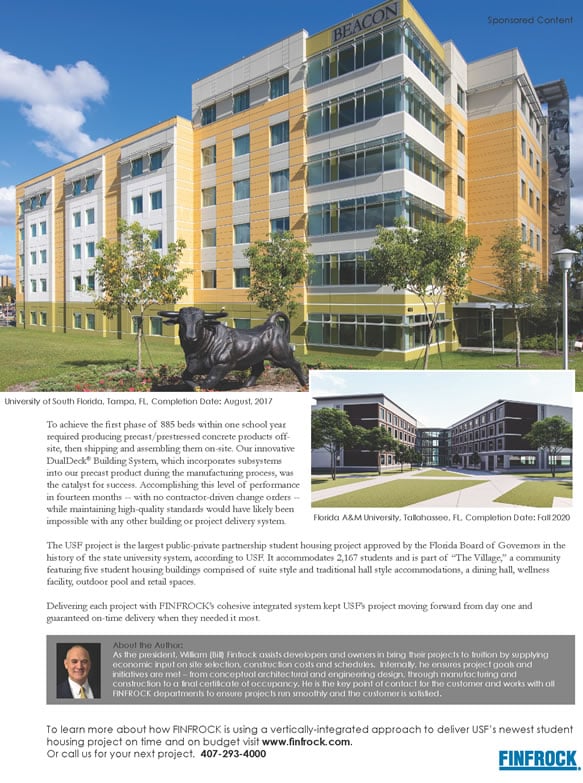Ball's liquor still lies unopened, but his company has put on some new clothes and headed for the party, escorted by chairman and chief executive officer Peter S. Rummell, the former real estate chief for the Walt Disney Co. who cut his teeth developing high-profile Florida communities such as Sawgrass in Ponte Vedra Beach and Celebration near Orlando. Since a group of activist shareholders and outside directors that included Jacksonville businessman Herbert Hill Peyton mounted a push that installed Rummell last year, the new CEO has frenetically set about reshaping Ball's creaky behemoth as a major regional - even national - real estate developer, and has set in motion a plan that could remake the whole northwest corner of the state.
Gone is the old St. Joe Paper Co. name, replaced by the St. Joe Co. with a new ticker symbol [NYSE-JOE] and a new logo, a stylized bird taking flight. Gone also are all but one of the company's previous seven top managers, replaced with high-priced new blood. More notable, the bespectacled Rummell has catapulted the company into a series of partnerships, acquisitions and real estate ventures, including three massive residential real estate developments in the Panhandle that the company will try to carry out simultaneously. Among the other deals: Rummell's $12 million purchase of Arvida, one of Florida's most storied residential community builders, and the $90 million pending acquisition of the Prudential Florida realty brokerage.
Rummell also bought former golf pro Steve Melnyk's golf course development company and has made joint venture deals with commercial developers, including The Codina Group in Miami and CNL Group in Orlando. In St. Joe's biggest departure from its roots, Rummell acquired an interest in a Seattle-based company that designs games and cut a deal with the National Football League to open a chain of football-themed entertainment centers. Asked whether it's all too much too fast, Rummell brushes off the question. "My concern is exactly the opposite. I get up every morning worried that we're going too slowly." Rummell, who characterizes himself as a shy type [see story, page 37] has taken considerable pains to make sure St. Joe's transformation gets noticed: The company's moves have played out under the spotlight of a public relations campaign calculated to keep St. Joe on the pages of the nation's business press - and in investors' sights.
But the initial heat generated by Rummell's appointment and by his early deals to get St. Joe moving has cooled. The company's stock price, which jumped by more than 50% in the nine months after Rummell took over - boosting the company's market value by more than $1 billion - has settled back from around $36 to $27 per share. Rummell may not be slowing down, but he and St. Joe are only now beginning to confront the reality of what it will take to make over Ed Ball's old collection of paper mills, pine forests and railroads. In making his sprint for greatness, Rummell has made two big bets - neither a sure thing. One is that he can deliver enough earnings growth to keep investors happy as they await a big payoff from St. Joe's real estate ventures. Two: Rummell is wagering that there's a different kind of retiree in the demographic pipeline, one willing to buy farther north than previous generations of Florida-bound retirees, in St. Joe territory that has few of the attributes that have traditionally attracted retirees. To be sure, Rummell isn't short on ammunition. St. Joe has $500 million in cash and short-term securities, and, remarkably, no long-term debt. Its market cap - the value of all of its stock - is roughly $2.5 billion. Best of all, St. Joe's land is on the books for a mere fraction of what a developer would have to pay for the same property today. "There's no interest meter on our land as we develop," says St. Joe's No. 2 executive, President and Chief Operating Officer Charles A. Ledsinger Jr. "That gives us staying power."
Advantages
In addition, investors and Florida real estate executives who have worked with Rummell say he has the skill and experience to steer St. Joe. In the early 1980s at Arvida, Rummell learned about developing communities from some of the state's top talent, including Arvida founding partners Chuck Cobb and John Temple. Later at Disney, Rummell experienced firsthand the constraints imposed by the company's rigid approach to developing Celebration - the highly touted neo-traditional community near Orlando.
Rummell also has given his managers a lot of autonomy, making the company quick and responsive. The developer of the World Golf Village south of Jacksonville, James Davidson, still marvels at how much latitude St. Joe executive David D. Fitch had when St. Joe purchased 400 acres at World Golf for a nearly 2 million-square-foot office/industrial project. Fitch, St. Joe's senior vice president and general manager of commercial and industrial development, "had the authority," Davidson says. "Within hours St. Joe can cut a deal." Even with all those advantages, Rummell knows investors want to see earnings growth. And even as he preaches patience to Wall Street, Rummell acknowledges that he and his managers must find ways to deliver results sooner rather than later. "We're up to our ass in assets. We don't need assets. We need earnings," he says. "That doesn't mean we won't go and buy some assets if we find something really interesting. But our acquisition strategy is focused on operating companies that are complementary to what we do." Unfortunately for St. Joe, none of Rummell's moves so far appears to offer more than a near-term boost to the company's 1997 pre-tax earnings of $83.4 million (on revenues of $346 million). The company expects the Prudential Florida realty firm to generate about $15 million a year in pre-tax earnings, which on an annualized basis could generate a nice, one-time 18% boost to St. Joe's pre-tax earnings. But analysts question whether Prudential, once it's part of St. Joe's base, can generate enough growth to get St. Joe near its stated goal of increasing pre-tax earnings by 20% each year. Some in the real estate community, which generally holds Rummell in high regard, wonder privately whether he overpaid for Prudential. Rummell defends the deal. "We think there's terrific growth opportunity," he says. "It's a good platform for us." Elsewhere, St. Joe will hunt for earnings by trying to squeeze more rental income from its existing portfolio of 60 office and industrial properties, which it controls through its majority ownership stake in the company that owns Florida East Coast Railroad. Fitch lauds Florida East Coast managers, but says the properties can deliver higher profits by employing more sophisticated operating systems and more aggressive marketing. Fitch's group also plans to develop 1.5 million square feet of new office and industrial space each year, with expertise acquired when it bought The Codina Group, the real estate development firm owned by Armando Codina, whose former partner, Jeb Bush, is running for governor.
Other projects with earnings payoffs are at best years away. St. Joe executives say the earliest they could get one of its football-themed entertainment centers - tentatively called NFLX - underway is late 1999. And significant returns from the company's biggest potential cash cows - the large-scale residential and resort communities Rummell wants to build on St. Joe land near Tallahassee and along the Gulf of Mexico in Walton County - are even further down the road.
In Tallahassee, the company has unveiled plans to build a mixed-use community of 4,000 homes called Southwood on 3,000 acres six miles from downtown. Along the Gulf of Mexico in Walton County, St. Joe envisions two new residential and resort communities - Camp Creek and Seagrove, which is adjacent to Seaside, the successful neo-traditional community where home values average $460,000. To attract visitors and potential homebuyers, St. Joe plans to build hotels, beach clubs and golf courses on the sites.
Those developments offer enormous potential payoffs, but can take two to three years of permitting and planning. And of the 5,000 acres St. Joe has initially identified for the three community and resort developments, none is permitted. In other words, the company will be spending millions of dollars over several years preparing the properties before any sales begin pouring cash back into corporate coffers. St. Joe officials thus may be overly optimistic when they say residential housing sales will make up about half of St. Joe's overall revenues in about five years. Davidson, of World Golf Village, says it took about a decade before his project - which had deep-pocket backing from Memphis cotton magnate Billy Dunavant - began generating much cash. Davidson also had the freedom of operating outside the constraints of a publicly traded company.
Arvida's role
Further complicating the picture is the fact that Arvida, the developer that Rummell is relying on to oversee its big projects, isn't the same company it was when Rummell worked there. Arvida is still a well-known name among the homebuying public, and St. Joe will be able to promote Arvida's track record, which includes more than 50 master planned communities with more than 35,000 new homes. But all but two of the firm's top 20 managers during its glory years left when Disney sold the company to JMB for $400 million in 1987. Arvida's present managers have no experience building communities in northwest Florida. Moreover, it's been 10 years since Arvida steered a project through the complicated and costly Development of Regional Impact (DRI) process.
Not a problem, answers Rummell: St. Joe is brimming with executives who have had extensive experience maneuvering through the DRI maze, including Rummell himself and Robert Rhodes, a prominent real estate development attorney who worked at Arvida and Disney and is now the company's general counsel and senior vice president. In fact, St. Joe officials say their permitting process is moving along nicely and they don't anticipate any roadblocks. "We hope to turn dirt by early 1999," says Timothy Edmond, the Arvida vice president overseeing development of Southwood as well as Seagrove and Camp Creek.
But even if Southwood, Camp Creek and Seagrove end up being home runs, St. Joe will most likely have to stay on the acquisition trail to reach its 20% a year earnings growth goal. Rummell says he's looking around for a company with proven management and profits. While he won't give any specifics on companies he's considering, Rummell says his pick will be real estate related. Meanwhile, Rummell and Ledsinger continue to tell investors and analysts that St. Joe is a buy-and-hold proposition. When St. Joe's first-quarter per-share cashflow estimates missed analysts' expectations by a few pennies and Morgan Stanley Dean Witter real estate analyst Gregory Whyte downgraded the stock, Rummell says he had to spend a week retelling the St. Joe story to analysts and investors alike. "Quarter to quarter earnings for the next couple of years are not going to be relevant," he says. "They're not going to be a true measure of what we're doing. We're still coming out of the box."
Making it work
To get an idea of what it'll take Rummell to succeed with his second big bet, meet Ty Warren, a 48-year-old public and corporate affairs consultant, and his wife, LaVone, an assistant dean of the law school of Samford University in Birmingham. The Alabama couple are part of the baby boom demographic bubble that enters retirement age within the next few years, and St. Joe must capture its share of that group for Seagrove and its other developments to prosper. The Warrens hope to retire in about 10 years; two years ago, they began casually looking for a "community with easy access" in which to buy a retirement home. In St. Joe's favor are the facts that the Warrens will be retiring earlier than their parents' generation. And because boomers have traveled more than their parents, the Warrens and others will be more willing to relocate: Historically, only about 5% of all retirees have been willing to leave their home states, and the increased willingness to move ... today 15% to 20% ... means there should be no shortage of demand for retirement communities.
The Warrens also embody the growth that's occurred in the southeastern Sunbelt states over the past 20 years; St. Joe will be able to market its Panhandle properties to a big group of retirees who are relatively nearby, instead of far off in the Northeast and Midwest. For its Walton County projects, St. Joe will target retirees, vacationers and pre-retirees within an arc that cuts across Texas, Louisiana, Arkansas, Tennessee and Georgia. The company says its market studies support its contention that retirees and pre-retirees in the South will be interested in vacationing and buying homes in northwest Florida. As Alabama natives, the Warrens have frequented Florida's northwest coastline and have no qualms about retiring to that part of the state. "Our research shows the market is a lot deeper and broader than we thought," Rummell says.
In developing Southwood and its other properties, however, St. Joe has to appeal to a group that wants more than golf. Like many baby boomers, Warren plans to work part-time out of his home after leaving his full-time job. The couple is looking for a community that offers a range of activities from continuing education and fine dining to golf and fishing.
The retirement community anchored by golf , shuffleboard and a clubhouse may become a thing of the past, say experts on retirement communities. New age retirees are expected to be more active, demanding amenities like wellness centers and computer rooms, educational offerings and employment opportunities. Climate may be less important than being near a university. "There's a transition underway," says David Parker, a real estate consultant in Jacksonville who specializes in retirement communities. "The change is from facility-based retirement communities to activity-based communities." Still, Rummell and his team face tall hurdles. They can't capitalize on an existing strong flow of in-migrants into northwest Florida, for one. And growth projections for the region don't offer much promise, either. Consider: Walton County's population, which grew by about 4,000 from 1991 to 1995, is expected to advance by nearly 5,000 from 1996 to 2000, according to the Bureau of Economic and Business Research at the University of Florida. The forecast isn't much rosier for Tallahassee, where only 1,000 new homes are built each year. Indeed, north Florida, especially the Panhandle, isn't getting its share of the state's large in-migration of retirees, argues Florida State University geographer Mort Winsberg, who predicts that counties north of Alachua will not be attracting a larger share of older residents in the coming years. "They have a tough sell," he says of St. Joe's plans.
And as St. Joe tries to persuade retirees to settle in areas with a cooler climate, it will be facing stiffer competition from non-traditional retirement states such as Alabama, Mississippi, Tennessee and South Carolina, which have become more aggressive in marketing to retirees. There's also no shortage of competition within Florida: Other players will include Del Webb, the Phoenix-based developer that operates 16 retirement communities throughout the Sunbelt, and has recently bought two in Ocala. Traditional homebuilders such as Lennar Corp. and Pulte Corp. also are keen on building age-restricted retirement communities.
Part of St. Joe's strategy is to participate actively in the overall economic development of northwest Florida, abandoning its old passive role as a corporate citizen. In Tallahassee, Edmond, the Arvida vice president, figures by the end of July he'll have met with representatives from some 60 different environmental and citizens organizations that have an interest in the Southwood project. To help win support for Southwood, St. Joe has promised to build affordable housing, protect hardwood trees and give land to the state for construction of a medical school.
St. Joe management hopes to attract new industry, perhaps healthcare or high-tech companies, to spur home sales at Southwood. "West Florida, from Panama City to Destin, draws 7 million visitors each year," Rummell says. "It doesn't need to be established, it needs to be supplied a series of products that will attract first-, second-home or retirement buyers." That, Rummell says, includes better highways, air service and medical facilities, all of which St. Joe executives plan to promote.
It's still early in St. Joe's transformation, and for the moment, Rummell can proceed without looking over his shoulder. He has complete support from St. Joe's board of directors and the trustees of the Alfred I. duPont Trust, which owns 56% of St. Joe's stock. Although St. Joe made shares more readily available to the public in 1990, previous management stubbornly dragged its feet when it came to trying to unlock the underlying value of the company's vast land holdings. Litigation brought by former CEO Jacob Belin, the addition of outside directors like businessmen Walter Revell and Russell Newton, and vocal criticism from shareholders like Jacksonville investor James Dahl broke the logjam. "We told him to turn the crank and make it work," says Peyton, president of Jacksonville-based Gate Petroleum and a duPont trustee. "He's assembled an excellent team, and we're very optimistic St. Joe is on the right track."
--------------------------------------------------------------------------------
Leading Man in the St. Joe Saga
If Hollywood producers were looking to cast the prototype of a hotshot Florida real estate developer, they'd most likely overlook Peter S. Rummell. He's shy, sports no gold jewelry and, judging from his pale complexion, doesn't spend much time in Florida's blazing sunshine. Yet, Rummell, 52, in his new role as chairman and chief executive officer of St. Joe Co., is indeed the lead character in what could become one of Florida's grandest real estate development dramas: the potential reshaping of an entire region of the state. Rummell has been given 1.1 million acres of land, mostly in northwest Florida, half-a-billion in cash and securities, and a sweeping mandate to develop communities, resorts, office buildings - really anything he thinks will add value to St. Joe's bottom line. "Not many people in the history of this industry have had this opportunity," marvels Anthony Trella, a real estate consultant in Deerfield Beach. "It's incredible."
Rummell, who favors dark blue dress shirts and red ties, squints at the afternoon sun streaming into his office overlooking the St. Johns River in Jacksonville as he talks about the pressure of performing before a tough audience: fellow real estate executives and Wall Street investors. The scrutiny and second-guessing of Rummell's moves will increase as St. Joe unveils more specifics about its plans. "I'm not a particularly comfortable public person," Rummell says. "I'm a shy person by instinct." But, he adds, he's "perfectly comfortable" in his role as the CEO picked to transform St. Joe into a real estate juggernaut. "One of the things that makes me valuable now is my 25 years of experience," he says. "From a tactical and practical point of view, I can avoid a lot of simple planning mistakes." Rummell is being paid well for his talents and expertise: His 1997 salary was $591,538, and he earned a $300,000 bonus. In addition to his base pay, St. Joe's directors have given Rummell lots of incentive to keep the stock price rising: If St. Joe's share price increases by 10% a year over the next decade, his stock options will be worth $123 million.
Rummell's been involved in the creation of a number of high-profile communities. He got started in 1973 working for the Sea Pines Co. at Hilton Head Island, S.C. After several years, Sea Pines sent him south to manage its Amelia Island Plantation community near Fernandina Beach. His next management position kept him in Florida, where from 1977 to 1983 he served as president of Arvida's Sawgrass development in Ponte Vedra Beach. He spent two years as vice chairman of Rockefeller Center Management Corp. in New York City, only to return to Arvida. After Walt Disney Co. acquired Arvida in 1985, Rummell joined the entertainment giant, where he put Disney into the real estate development business. Over the next 11 years, he oversaw the development of Disney hotels, theme parks, including Euro Disney, and Celebration, the neo-traditional planned community near Orlando.
Rummell may be shy, but he's savvy when it comes to corporate visibility. In addition to revamping the company's logo, name and corporate report, Rummell's PR efforts led to profiles in the New York Times and Fortune. "Peter's a real pro," says John Temple, a former president of Arvida who at one time had been grooming Rummell as his successor there.
At St. Joe, Rummell has surrounded himself with a cadre of former Disney and Arvida managers. While Rummell stays focused on St. Joe's grand strategy, he's turned his division heads loose to carry it out. "Peter is a supreme motivator," says P. Michael Reininger, St. Joe's senior vice president in charge of entertainment who worked for Rummell at Disney. "He gets you to perform at your highest level in a low-key manner."
Once an avid golfer and voracious reader, Rummell has little time for either pursuit these days, splitting his time between the office and his family - wife Lee Ann, whom he married nine years ago, daughter Mahala, 6, and son Harry, 3. A parent for the first time at 46, Rummell says fatherhood has altered his outlook on community development. "It gives you a whole different set of antennae in terms of what is important. Does it mean we spend more on playgrounds now that I have children? No. But it makes you think more about how neighborhoods and families work."












